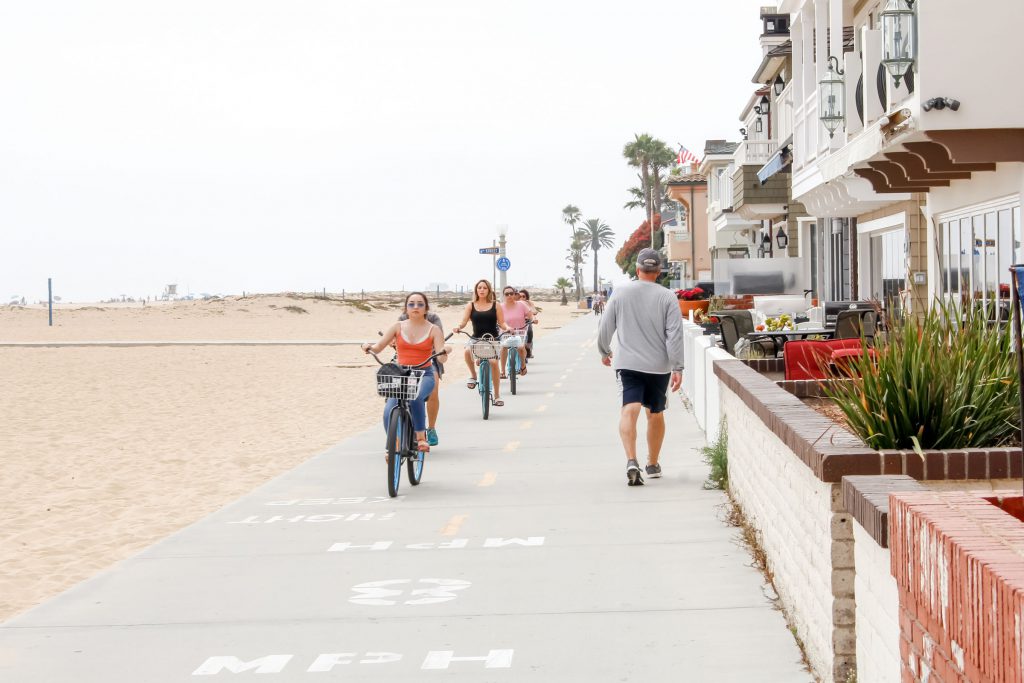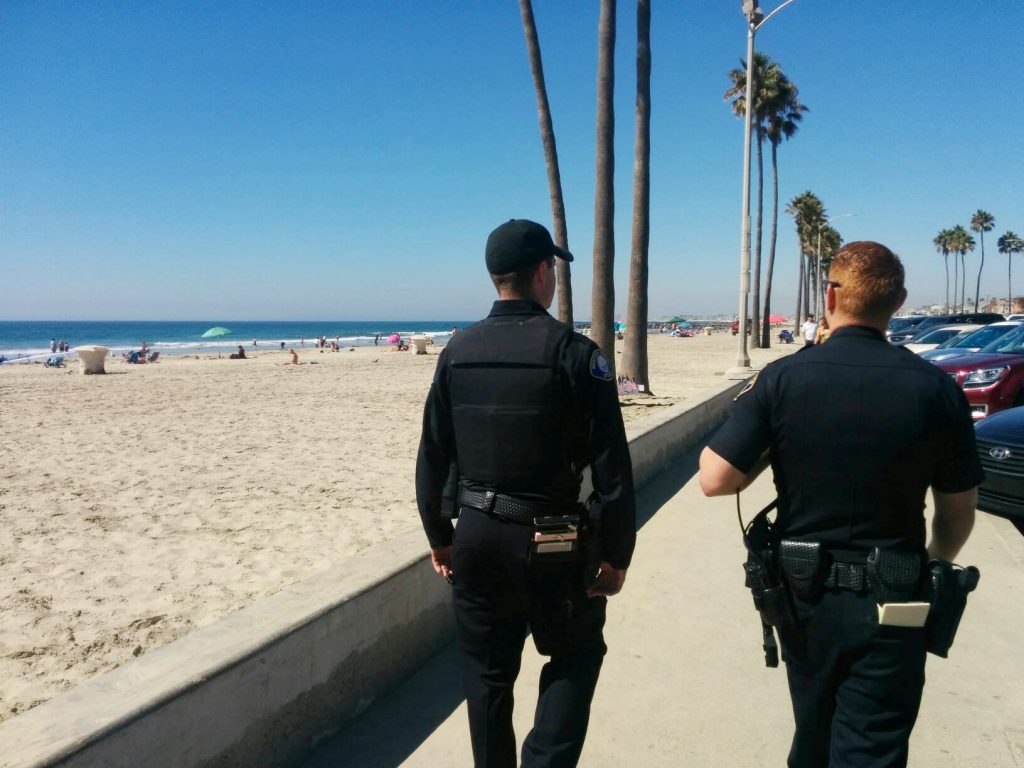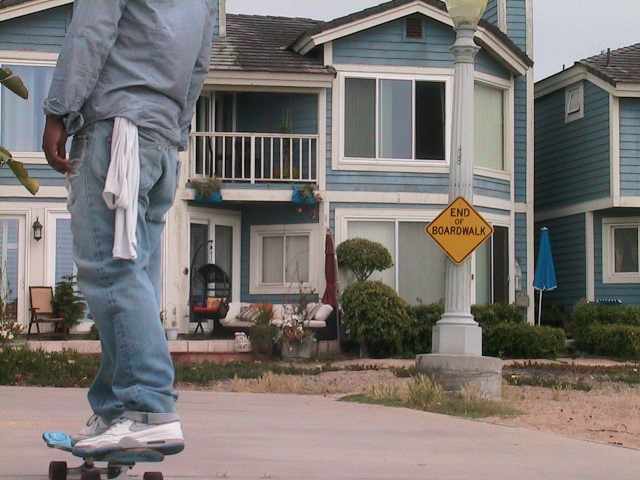
— Photo by David Tonelson / Shutterstock.com
Newport Beach City Council and local residents spent nearly two hours this week discussing possibly prohibiting motorized uses on the Oceanfront Boardwalk on Balboa Peninsula, a topic that has spurred debate for several years.
“Shared use of this amenity has been talked about for decades,” City Manager Grace Leung wrote in her Insider’s Guide. “Yes, we found a staff report from 1980 on the subject of bicycles on the Boardwalk.”
Once again, opinions were split on the issue during a City Council study session on Tuesday.
People mostly agreed that speed was the primary concern, but couldn’t reach a consensus on whether or not banning e-bikes was the solution.
Councilwoman Diane Dixon, whose district covers the peninsula, said she wants to come up with a solution that works for everybody.
“We want to be a welcoming community, but we want to be a safe community,” Dixon said.
It’s a “scenic jewel” that’s very popular by both visitors and locals in the city, Senior Civil Engineer Brad Sommers said during the presentation.
It’s been a longstanding area of concern for residents, mostly related to “poor user behavior,” Sommers said, like speeding or unsafe operations. That concern has gown recently because of the increase in use of electric bikes.
According to city code, the oceanfront is defined as a “walkway” with an 8 miles-per-hour speed limit. Motorized scooters are prohibited. The municipal code also states that “unsafe operation” is not allowed and it establishes direction of flow/rules of the road.
The Oceanfront Improvement Project, which is included in the current city budget, will review and consider upgrades to the boardwalk, including possibly adding a second path and/or widening the current path. Staff hopes to bring a consultant agreement back in spring.

— Photo courtesy Newport Beach Police Department
Other possible plans discussed Tuesday include revising the municipal code, updating signs with revised restrictions, prohibit electric bikes and other motorized conveyances (while possibly still allowing powered devices exclusively for mobility or disable persons, and/or also possibly allowing electric bikes to be used without the power assist). Or simply maintain current restrictions.
In a straw poll at the end of the discussion, only Mayor Pro Tem Brad Avery and Mayor Will O’Neill voted for maintaining the current regulations.
Council members Joy Brenner, Marshall “Duffy” Duffield, Diane Dixon and Jeff Herdman raised their hands in support of prohibiting electric bikes.
Dixon and Herdman supported possibly updating the signage and, along with Avery, possibly revising or updating the municipal code to consider future technology and revising the list of prohibited devices.
Muldoon, Dixon, Herdman, and Duffield all supported a potential speed bump option.
Dixon and Brenner were the only two in support of the pilot program Dixon suggested (ban only during certain hours).
All seven raised their hands in support of raising the fine.
During the study session, more than two dozen public speakers commented on the issue.
Speaking in opposition to the possible ban were several bike shop owners and store employees, and residents who own e-bikes. Many agreed that speed is the problem, not the type of bike. The speed limit should be regulated and strictly enforced.
“All bikes should be treated the same,” said resident Larry Tucker, who owns several e-bikes.
The speeders are not necessarily electric bike riders, Tucker said. The 8 mph is pretty easy to pass on a regular or an electric bike, he noted.
A number of local residents noted that they own electric bikes, which have helped them get around as they age and it becomes harder to pedal their own bike.
On the other side of the issue, Peninsula resident and Central Newport Beach Community Association President Maureen Cotton said the majority of the residents by the boardwalk are “vehemently opposed” to electric bikes and other vehicles on the boardwalk.
They could develop a handicap sticker for bikes for people with mobility issues, Cotton suggested.
She has seen people knocked over and get hurt, including broken bones.
“It’s really, really genuinely hazardous,” Cotton said. “The reality is, there is an enforcement issue.”
Several speakers agreed that e-bikes weigh more, can’t stop as quickly, and are faster.
Longtime resident Nathan Matson said it’s about safety and how fast the bikes can go. He sees e-bikes speeding on the boardwalk every day.
“If there’s power there, people are going to use it,” he said.
He suggested removing the ability to rent electric bikes in the city.
Electric skateboards are just as dangerous, a few people pointed out.

— NBI file photo by Eric Longabardi
E-bikes have a lot of torque and can start very quickly, but are difficult to stop, Duffield said. Also, the e-bikes can go much, much faster than regular bikes, some up to 70 mph, he said. As technology improves, they will be cheaper to buy and there will be more of them on the road.
Things have changed with bike riders, Duffield added
Until they figure out how to enforce it, which is a challenge, something needs to be done, he said.
“We have to do something and do it quickly,” Duffield said.
People were also split on possible solutions.
There was disagreement on whether the blinking lights, signage, or speed bumps actually work.
The problem is now, widening or building an extra lane is years away, resident Fred Levine said. Enforcement might be the way to go, but speed bumps and blinking lights don’t work, he added. He sits on the beach and sees children, pets, and adults get hurt.
“We have a boardwalk that is like the 405 freeway,” Levine said. “I’m seeing what’s going on… We do have a problem on the boardwalk, we all know it, now let’s come up with some solutions.”
There have been several interesting ideas suggested, Dixon said, including better and possibly blinking signage. She also suggested looking into a “walking zone” and a summer pilot program for limiting hours of operation for bikes. Dixon also recommended strengthening the fines for violators. Essentially prohibiting it during the busiest hours and better enforcement during all other hours.
“It’s meeting in the middle,” she said.
Short of having a police officer on every corner, she’s not sure what else they can do to improve enforcement, Dixon said.
Very few people are adhering to the current rules. Their past efforts are not having the impact they wanted, she added.
“We have a capacity issue on the boardwalk,” Dixon said. “We have a problem; how can we solve this?”
Bikes aren’t allowed on the Balboa Island boardwalk and so this isn’t a problem there, Herdman said. It’s a safety issue and that’s one of the basic responsibilities of the Council, he added.
It’s not a popular solution and people are split on this issue, he said, but it has got to be done.
“The problem is not going away,” Herdman said. “We’ve got to take care of it.”
Most Council members emphasized public safety and several commented support of some kind of ban.
Although not everyone was a fan of the ban.
The answer to people not following the current rules is not to add more rules, Mayor Will O’Neill said.
A legislative firing squad isn’t the answer, and he won’t support any additional bans, Muldoon commented. The real issues are speed and safety, he agreed.
Before banning something, they need to get to the root of why they were concerned in the first place, O’Neill said. Speed is the primary issue and so enforcement is the answer. It’s like a Honda Civic versus a Tesla, just because something gets to the speed limit faster doesn’t mean it should be banned, it’s about enforcing the limit on all vehicles, O’Neill said.




